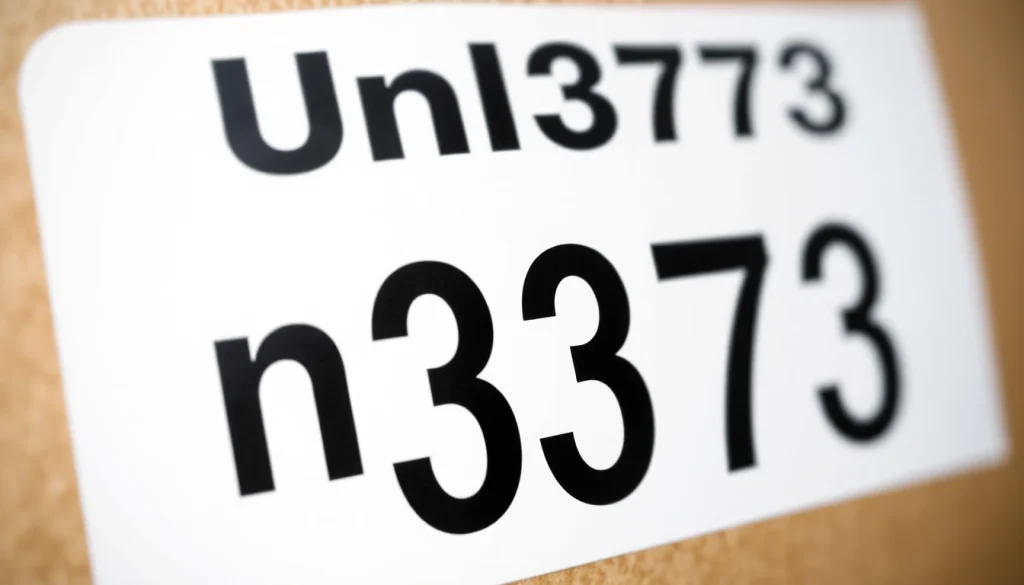Essential Guidelines for Using the UN3373 Label in Shipping Biological Substances

Understanding the UN3373 Label
What Is the UN3373 Label?
The UN3373 label is an essential component in the transport of biological substances categorized specifically under Category B, which includes diagnostic specimens. This classification is vital for ensuring that materials such as blood, tissues, and other biological samples are handled and shipped safely and in compliance with international regulations. The label serves as a warning and provides critical information about the contents, ensuring that anyone involved in the shipping process understands the nature of the materials being transported. For example, human blood samples that may contain infectious pathogens must be correctly labeled to minimize risks to handlers and the public.
Significance of Category B Biological Substances
Category B biological substances, represented by the UN3373 label, cover a wide range of materials. These may include human or animal specimens intended for research or diagnostic purposes. The significance of properly tagging these substances cannot be understated. It not only protects the individuals handling them but also adheres to legal frameworks governing the transport of potentially hazardous biological materials. It’s imperative to maintain a clear distinction between Category A and Category B substances, wherein Category A includes contagious materials capable of causing permanent harm or death. Understanding this distinction ensures compliance with international shipping laws enforced by the International Air Transport Association (IATA) and other regulatory bodies.
Regulatory Requirements for UN3373 Labeling
The UN3373 labeling process is governed by strict international guidelines that mandate specific requirements for packaging and documentation. These regulations are designed to safeguard public health and safety while accommodating the global movement of biological materials. The label must include the designation “Biological Substance, Category B,” along with the UN3373 code prominently displayed within a diamond-shaped sign. In addition, it must be accompanied by appropriate packaging that meets UN performance specifications.
When to Use the UN3373 Label
Applicable Situations for Category B Materials
UN3373 labels should be applied in various scenarios, including the transportation of clinical specimens to laboratories for testing, sending research biological samples that are not known to carry infectious agents, and other related contexts. Whenever biological samples are shipped, especially across borders, utilizing the UN3373 label ensures that all safety protocols are followed and that the materials are accurately identified. This practice minimizes the potential for mishandling and enhances the overall integrity of the specimen being transported.
Common Misconceptions About UN3373 Labels
There are several misconceptions surrounding the UN3373 label. One common belief is that if a sample appears non-infectious, it does not require labeling. However, even samples that do not display symptoms of infection must still be labeled properly to adhere to regulations and ensure safe transport. Additionally, some may think that only large laboratories or medical facilities need to comply. In reality, any entity involved in the transport of biological substances, including research institutions and small clinics, must understand and implement these labeling requirements.
Real-World Examples of UN3373 Label Usage
In practice, various industries utilize the UN3373 label for different purposes. For instance, a clinical laboratory may send human serum samples to another facility for analysis. Given that these samples could contain genetic materials or pathogens, proper labeling with a UN3373 label becomes crucial for the shipping process. Furthermore, research institutions studying zoonotic diseases often send animal samples across borders for international studies, and adherence to the UN3373 label guidelines enhances the safe flow of these materials.
How to Properly Label UN3373 Shipments
Required Information on the UN3373 Label
Accurate completion of the UN3373 label is paramount for successful compliance with shipping regulations. The label must include:
- The wording “Biological Substance, Category B” adjacent to the UN3373 identification.
- The diamond-shaped mark that signifies the UN3373 classification.
- Sender and recipient information if required by local regulations.
- Any additional markings or instructions as necessary for safe handling.
Best Practices for Label Placement
The placement of the UN3373 label is equally important as the information contained within it. It should be affixed to the outer packaging of the shipment, ensuring it is readily visible. Maintaining a clean and unobstructed surface where the label is adhered is crucial to avoid damage during transit. It is advisable to position the label on one side of the package rather than the top, which may be overlooked during handling processes.
Common Mistakes to Avoid with UN3373 Labeling
There are common errors that shippers should diligently avoid to ensure compliance and safety. These include:
- Neglecting to check the label for damage or fading before shipping.
- Failure to use the appropriate packaging that meets UN specifications.
- Misclassifying the contents leading to safety violations.
- Forgetting to document any special handling requirements associated with the samples.
Ordering and Customizing UN3373 Labels
Where to Purchase UN3373 Labels
Organizations needing UN3373 labels can source them from various suppliers specializing in shipping and medical labels. It is crucial to select a vendor that offers compliance with both domestic and international shipping regulations. One option for timely and compliant labeling solutions is un3373 label providers that cater to specific industry needs, ensuring that labels are easy to read and withstand the rigors of shipping processes.
Customizing Your UN3373 Label for Specific Needs
Customization of the UN3373 label may be necessary for organizations with unique requirements. Custom labels can incorporate specific logos, additional handling instructions, or particular colors that align with a company’s branding. Some suppliers allow for such solutions, ensuring that essential information is highlighted while maintaining compliance with regulatory requirements. It is advisable to consult with labeling experts in order to design a label that meets all logistical needs while also ensuring clear communication of handling protocols.
Types of UN3373 Labels Available in the Market
Various types of UN3373 labels are available, each designed for specific uses and environments. These may include:
- Adhesive labels suitable for different package types.
- Water-resistant labels for shipping in humid or wet conditions.
- Printable templates that allow for easy customization before shipment.
- Labels designed for specific transport modes like air freight.
FAQs About the UN3373 Label
What Are the Risks of Not Using the UN3373 Label?
Failure to utilize the UN3373 label when required can have serious consequences, including legal repercussions, financial penalties, and increased liability. Furthermore, the absence of proper labeling can lead to mishandling, risking exposure to potentially infectious substances. It is crucial that all involved parties recognize the importance of adhering to the labeling requirements established by governing bodies.
How to Interpret the UN3373 Label Information
Understanding the information presented on the UN3373 label is essential for safe handling and transport. The main elements to focus on include the hazard classification, specific biological substance indications, and handling instructions. This understanding helps ensure that all personnel involved are adequately informed about potential risks and necessary precautions when dealing with the labeled materials.
Future Trends in Biological Substance Labeling
The landscape surrounding biological substance labeling is evolving, with technological advancements leading to more sophisticated labeling solutions. Emerging trends include the use of QR codes on labels that can provide additional information regarding the specimen’s handling, tracking capabilities, and associated documentation digitally accessible throughout the shipping process. As regulations continue to adapt in response to global health considerations, staying updated with labeling practices will become a critical component in biological transport logistics.







